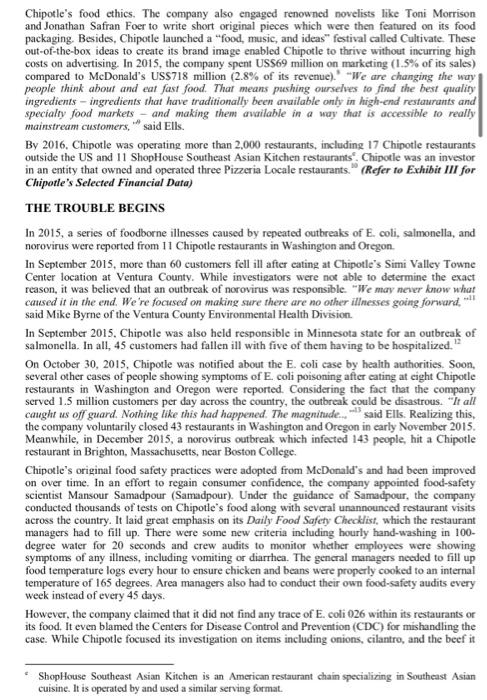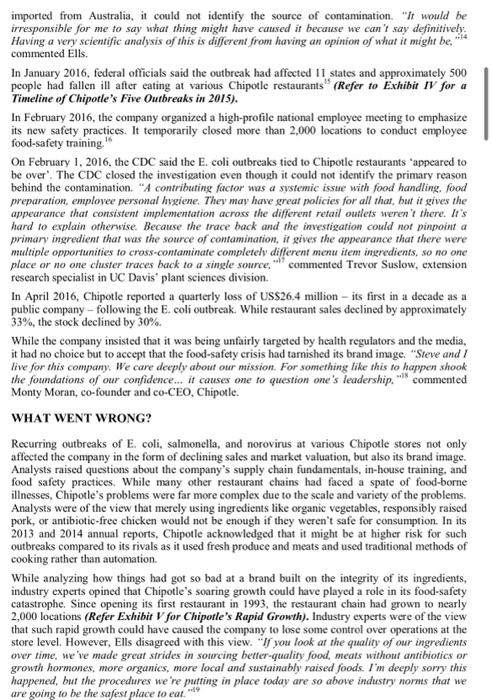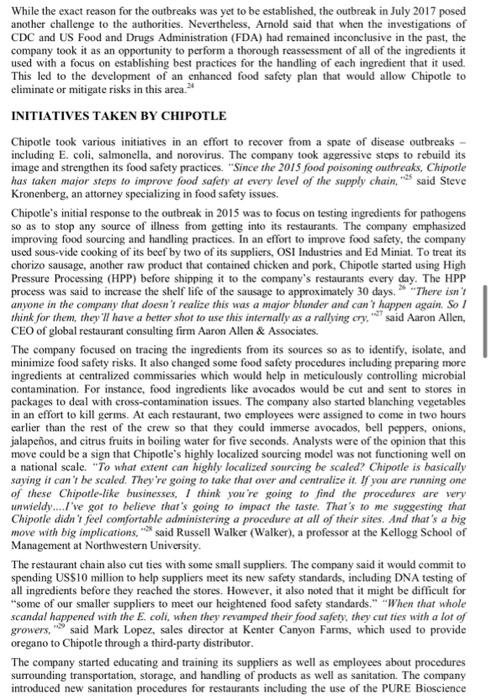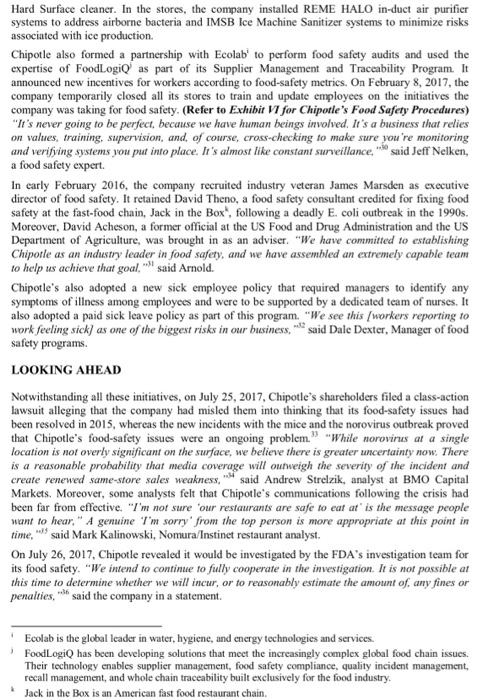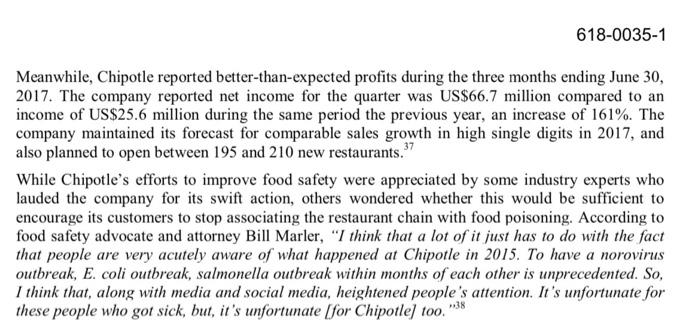Based on the case study Chipotle Mexican Grill: Quality At
Stake.
Please answer the following questions accurately and thoroughly.
- Identify and give specific examples of the different costs of quality incurred by Chipotle in dealing with this quality crisis. ( Prevention costs, Appraisal costs, External failure costs, Internal failure cost)
- Make recommendations (with rationale for your suggestions) to the CEO of Chipotle on actions the company can take to restore shareholder and consumer confidence.
- Do you think Chipotle's process control and quality control practices were adequate?
What were the main shortcomings of the processes?
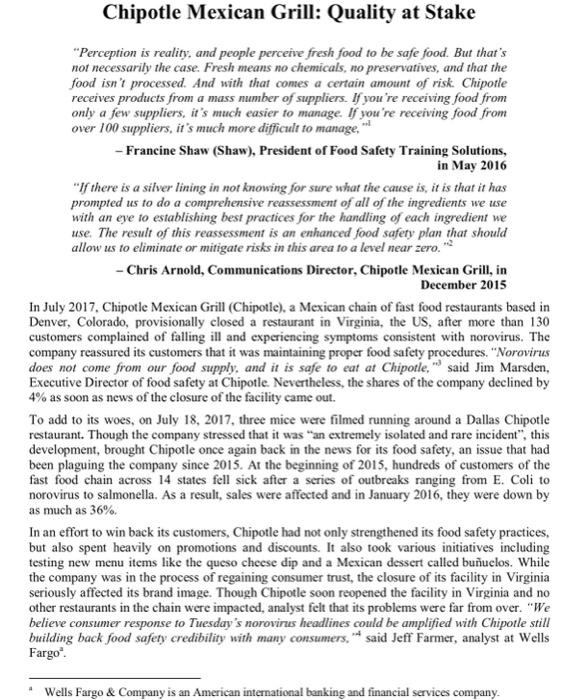
Chipotle Mexican Grill: Quality at Stake "Perception is reality, and people perceive fresh food to be safe food. But that's not necessarily the case. Fresh means no chemicals, no preservatives, and that the food isn't processed. And with that comes a certain amount of risk. Chipotle receives products from a mass number of suppliers. If you're receiving food from only a few suppliers, it's much easier to manage. If you're receiving food from over 100 suppliers, it's much more difficult to manage, " - Francine Shaw (Shaw), President of Food Safety Training Solutions, in May 2016 "If there is a silver lining in not knowing for sure what the cause is, it is that it has prompted us to do a comprehensive reassessment of all of the ingredients we use with an eye to establishing best practices for the handling of each ingredient we use. The result of this reassessment is an enhanced food safety plan that should allow us to eliminate or mitigate risks in this area to a level near zero." - Chris Arnold, Communications Director, Chipotle Mexican Grill, in December 2015 In July 2017, Chipotle Mexican Grill (Chipotle), a Mexican chain of fast food restaurants based in Denver, Colorado, provisionally closed a restaurant in Virginia, the US, after more than 130 customers complained of falling ill and experiencing symptoms consistent with norovirus. The company reassured its customers that it was maintaining proper food safety procedures. "Norovirus does not come from our food supply, and it is safe to eat at Chipotle," said Jim Marsden, Executive Director of food safety at Chipotle. Nevertheless, the shares of the company declined by 4% as soon as news of the closure of the facility came out. To add to its woes, on July 18,2017 , three mice were filmed running around a Dallas Chipotle restaurant. Though the company stressed that it was "an extremely isolated and rare incident", this development, brought Chipotle once again back in the news for its food safety, an issue that had been plaguing the company since 2015. At the beginning of 2015, hundreds of customers of the fast food chain across 14 states fell sick after a series of outbreaks ranging from E. Coli to norovirus to salmonella. As a result, sales were affected and in January 2016 , they were down by as much as 36%. In an effort to win back its customers, Chipotle had not only strengthened its food safety practices, but also spent heavily on promotions and discounts. It also took various initiatives including testing new menu items like the queso cheese dip and a Mexican dessert called buuclos. While the company was in the process of regaining consumer trust, the closure of its facility in Virginia seriously affected its brand image. Though Chipotle soon reopened the facility in Virginia and no other restaurants in the chain were impacted, analyst felt that its problems were far from over. "We believe consumer response to Tuesday's norovirus headlines could be amplified with Chipotle still building back food safety credibility with many consumers, "4 said Jeff Farmer, analyst at Wells Fargo. a Wells Fargo \& Company is an American international banking and financial services company. GROWTH OVER THE YEARS The history of Chipotle could be traced back to 1993, when Steve Ells (Ells), a graduate from the Culinary Institute of America, in Hyde Park, New York, opened the first store near the University of Denver campus, with a loan of US\$85,000 from his father. Ells's dream was actually to launch a fine-dining restaurant and he opened Chipotle to make the money to fund this restaurant. The name Chipotle was derived from the Mexican Spanish name for a smoked, dried jalapeo chili pepper. Within one month, the store was selling more than 1,000 foil wrapped burritos per day. With its fast and quality food service, Chipotle started getting noticed by consumers. "So many people fold me it was not a good idea to a start a restaurant, especially a fast-food restaurant. There was so much wrong with it: it was too spicy; everything was done by hand, from scratch. Everything was wrong. But that's why customers liked it; it's different, in the right way. If you have an idea, just go for it. If everybody is telling you that it's wrong, maybe that's an indication that it's an original idea, ". said Ells. Since opening its first restaurant in Denver in 1993, Chipotle had redefined the meaning of limited-service dining. In any Chipotle restaurant one could find as many as 16 employees working in the line and kitchen. Customers turned up in huge numbers, sometimes hundreds per hour. They could choose from among four meal items - burritos, burrito bowls, tacos, and salads as well as sides, made from just 64 ingredients. The emphasis was always on fresh ingredients and preparation. In an effort to ensure that all of its fresh ingredients were as safe as possible, Chipotle had to work closely with its suppliers. Moreover, the company also ensured that these ingredients were handled properly at the restaurants and prepared in the safest way possible. "When I created Chipotle in 1993. I had a very simple idea: Offer a simple menu of great food prepared fresh each day, using many of the same cooking techniques as gourmet restaurants. Then serve the food quickly, ,6 said Ells. In 1995, Chipotle opened its second store using the cash flow of the first restaurant. The next year, the third store was opened using a Small Business Administration (SBA) loan. Ells's father also invested an additional USS1.5 million. In the same year, Ells created a board of directors and raised an additional USS1.8 million. In 1998. McDonald's Corp (McDonald's) invested USS50 million in Chipotle. By 2001 , McDonald's had become the largest investor in Chipotle. Over seven years, McDonald's invested over US 360 million which helped the company to expand from 16 restaurants in 1998 to over 500 by 2005 . In October 2006, McDonald's fully divested itself of Chipotle, making more than USS1 billion in the process. In 2007, Chipotle went public and its stock increased by 100% on the first day itself. Despite its continuous emphasis on fresh ingredients, the company had been able to maintain profit margins of around 35.9\% (Refer to Exhibit I for Chipotle's Profit Margin Vs Other Major Chains and to Exhibit II for Chipotle's Share Price). In 2011, Chipotle's total annual revenue touched US\$2.2 billion, same-store sales increased by 11.2%, and the restaurant operating margin was 25.9%. "Chipotle has proven it has a better business model. Grow, invest, grow, invest. It's like a Warren Buffett tunch. They re in for the long haul of profits, not the quick version, ". said Clark Wolf, a restaurant consultant. In the competitive fast food industry, Chipotle differentiated itself by not adopting traditional promotional tactics like McDonald's McRib, Happy Meals, PlayPlaces, and dollar menus or KFC's d chicken-encased Double Down sandwich. Instead, it released animated films to promote The Small Business Administration (SBA) is a US government agency that provides support to entrepreneurs and small businesses. - McDonald's is a leading American fast food restaurant chain. AFC is an American fast food restaurant chain that specializes in fried chicken. Chipotle's food ethics. The company also engaged renowned novelists like Toni Morrison and Jonathan Safran Foer to write short original pieces which were then featured on its food packaging. Besides, Chipotle launched a "food, music, and ideas" festival called Cultivate. These out-of-the-box ideas to create its brand image enabled Chipotle to thrive without incurring high costs on advertising. In 2015, the company spent USS 69 million on marketing (1.5\% of its sales) compared to McDonald's USS718 million (2.8\% of its revenue)." "We are changing the way people think about and eat fast food. That means pushing ourselves to find the best quality ingredients - ingredients that have traditionally been available only in high-end restaurants and specialty food markets - and making them available in a way that is accessible to really mainstream customers, , said Ells. By 2016. Chipotle was operating more than 2,000 restaurants, including 17 Chipotle restaurants outside the US and 11 ShopHouse Southeast Asian Kitchen restaurants". Chipotle was an investor in an entity that owned and operated three Pizzeria Locale restaurants. (Refer to Exhibit III for Chipotle's Selected Financial Data) THE TROUBLE BEGINS In 2015, a series of foodborne illnesses caused by repeated outbreaks of E. coli, salmonella, and norovirus were reported from 11 Chipotle restaurants in Washington and Oregon. In September 2015, more than 60 customers fell ill after eating at Chipotle's Simi Valley Towne Center location at Ventura County. While investigators were not able to determine the exact reason, it was believed that an outbreak of norovirus was responsible. "We may never know what caused it in the end. We're focused on making sure there are no other illnesses going forward said Mike Byrne of the Ventura County Environmental Health Division. In September 2015. Chipotle was also held responsible in Minnesota state for an outbreak of salmonella. In all, 45 customers had fallen ill with five of them having to be hospitalized. On October 30, 2015, Chipotle was notified about the E. coli case by health authorities. Soon, several other cases of people showing symptoms of E. coli poisoning after cating at cight Chipotle restaurants in Washington and Oregon were reported. Considering the fact that the company served 1.5 million customers per day across the country, the outbreak could be disastrous. "It all caught us off guard. Nothing like this had happened. The magnitude.. 13 said Ells. Realizing this, the company voluntarily closed 43 restaurants in Washington and Oregon in early November 2015. Meanwhile, in December 2015, a norovirus outbreak which infected 143 people, hit a Chipotle restaurant in Brighton, Massachusetts, near Boston College. Chipotle's original food safety practices were adopted from McDonald's and had been improved on over time. In an effort to regain consumer confidence, the company appointed food-safety scientist Mansour Samadpour (Samadpour). Under the guidance of Samadpour, the company conducted thousands of tests on Chipotle"s food along with several unannounced restaurant visits across the country. It laid great emphasis on its Daily Food Safery Cheollist, which the restaurant managers had to fill up. There were some new criteria including hourly hand-washing in 100degree water for 20 seconds and crew audits to monitor whether employees were showing symptoms of any illness, including vomiting or diarthea. The gencral managers needed to fill up food temperature logs every hour to ensure chicken and beans were properly cooked to an internal temperature of 165 degrees. Area managers also had to conduct their own food-safety audits every week instead of every 45 days. However, the company claimed that it did not find any trace of E. coli 026 within its restaurants or its food. It even blamed the Centers for Disease Control and Prevention (CDC) for mishandling the case. While Chipotle focused its investigation on items including onions, cilantro, and the beef it ShopHouse Southeast Asian Kitchen is an American restaurant chain specializing in Southeast Asian cuisine. It is operated by and used a similar serving format. imported from Australia, it could not identify the source of contamination. "It would be irresponsible for me to say what thing might have caused it because we can't say definitively. Having a very scientific analysis of this is different from having an opinion of what it might be," i4 commented Ells. In January 2016, federal officials said the outbreak had affected 11 states and approximately 500 people had fallen ill after eating at various Chipotle restaurants 15 (Refer to Exhibit IV for a Timeline of Chipotle's Five Outbreaks in 2015). In February 2016, the company organized a high-profile national employee meeting to emphasize its new safety practices. It temporarily closed more than 2,000 locations to conduct employee food-safety training. 16 On February 1, 2016, the CDC said the E. coli outbreaks tied to Chipotle restaurants 'appeared to be over'. The CDC closed the investigation even though it could not identify the primary reason behind the contamination. "A contributing factor was a systemic issue with food handling. food preparation, emplovee personal hygiene. They may have great policies for all that, but it gives the appearance that consistent implementation across the different retail outlets weren't there. It's hard to explain othenwise. Because the trace back and the imvestigation could not pinpoint a primary ingredient that was the source of contamination, it gives the appearance that there were multiple opportunities to cross-contaminate completely different menu item ingredients, so no one place or no one cluster traces back to a single source, "commented Trevor Suslow, extension research specialist in UC Davis' plant sciences division. In April 2016, Chipotle reported a quarterly loss of US\$26.4 million - its first in a decade as a public company - following the E. coli outbreak. While restaurant sales declined by approximately 33%, the stock declined by 30%. While the company insisted that it was being unfairly targeted by health regulators and the media, it had no choice but to accept that the food-safety crisis had tarnished its brand image. "Steve and I live for this company. We care deeply about our mission. For something like this to happen shook the foundations of our confidence... it causes one to question one's leadership.. .1s commented Monty Moran, co-founder and co-CEO, Chipotle. WHAT WENT WRONG? Recurring outbreaks of E. coli, salmonella, and norovirus at various Chipotle stores not only affected the company in the form of declining sales and market valuation, but also its brand image. Analysts raised questions about the company's supply chain fundamentals, in-house training, and food safety practices. While many other restaurant chains had faced a spate of food-borne illnesses, Chipotle's problems were far more complex due to the scale and variety of the problems. Analysts were of the view that merely using ingredients like organic vegetables, responsibly raised pork, or antibiotic-free chicken would not be enough if they weren't safe for consumption. In its 2013 and 2014 annual reports, Chipotle acknowledged that it might be at higher risk for such outbreaks compared to its rivals as it used fresh produce and meats and used traditional methods of cooking rather than automation. While analyzing how things had got so bad at a brand built on the integrity of its ingredients, industry experts opined that Chipotle's soaring growth could have played a role in its food-safety catastrophe. Since opening its first restaurant in 1993, the restaurant chain had grown to nearly 2,000 locations (Refer Exhibit V for Chipotle's Rapid Growth). Industry experts were of the view that such rapid growth could have caused the company to lose some control over operations at the store level. However, Ells disagreed with this view. "If you look at the quality of our ingredients over time, we've made great strides in sourcing better-quality food, meats without antibiotics or growth hormones, more organics, more local and sustainably raised foods. I'm deeply sorry this happened, but the procedures we're putting in place today are so above industry norms that we are going to be the safest place to eat. Some analysts also wondered whether the company's focus on wholesome, simple ingredients had left it grappling with the operational challenge of managing a supply chain of small farms and suppliers. They questioned the viability of the company's model of scaling up a brand built around fresh, locally sourced ingredients. "It stands to reason that, regardless of industry or company, the more you proliferate suppliers, the harder it is to maintain quality. Obviously there's this great marketing appeal - freshmess, local, organic - and you and I and the public don't tend to see that message and think. "They've got a big management challenge." There, the marketers may have won the challenge too quickly, "200 commented Jeffrey Karrenbauer, President of supply chain consultancy Insight Inc. While Chipotle had set itself apart from its competitors with its emphasis on fresh, high quality locally sourced ingredients, its supply chain revealed something else. Its main pork supplier. Niman Ranch, was acquired by the agricultural giant Perdue in late 2015. Niman Ranch has been a pioneer in improving animal treatment standards by raising cattle and pigs 'naturally' without the use of hormones or antibiotics, whereas several lawsuits had been filed against Perdue for mistreatment of animals. Chipotle consumers were not happy with this development and expressed their concern on social media. However, Chipotle assured its consumers that the livestock would be raised under strict animal welfare protocols. "We have an internal team who visits our farms and checks on these things. Niman Ranch has a stellar reputation, one I am sare they want to keep, "=21 responded Chipotle from its official account. Chipotle also imported beef from Australia. At least 90% of the beef the company used in its products was supplied by large-scale suppliers like JBS Australia that also worked with McDonald's. A significant amount of lettuce was supplied by Taylor Farms, one of the world's biggest salad producers which supplied its products for Burger King'. Similarly, Chipotle's onions were purchased from River Point Farms, which also supplied to Subway B and Frito-Lay". All of its carnitas, barbacoa, and steak came from one of Chipotle's three largest 'central kitchens', Ed Miniat LLC. Ed Miniat processed 500,000 pounds of beef and pork each week for the company. While Chipotle was criticized for not being fully transparent about the sourcing of its food and all of its suppliers, it claimed that it had made the fast-food industry react to its culture of using fresh ingredients. "We do share some suppliers with other large restaurant companies. That does not mean we use the same ingredients or cooking methods, "w said Chris Arnold (Arnold), Communications Director for Chipotle. While it was felt that the vast network of suppliers might make it operationally challenging for the company to keep a close watch on all the products coming in from different places, analysts pointed out that it might be difficult on the part of small farms and suppliers to have access to the same resources as the bigger ones, like regularly conducting microbiological tests on products. Some analysts were of the opinion that the problem could have been with Chipotle's in-house training. The geographic spread of the outbreaks at the Chipotie restaurants indicated that the issue might be aggravated at the store level. "Given the fact that they had multiple foodborme illness outbreaks in such a short timeframe, a lot went urong. I think more than likely the crux of the issue is that at least on some level, there was a lack of training across the board. Because it wasn't at just one location. ..I think Chipotle got so focused with the 'Food With Integrity' cumpaign that they lost track of food safety in general, "31 said Francine Shaw, President of Food Safety Training Solutions. Burger King is a US-based global chain of hamburger fast food restaurants. . Subway is an American fast food restaurant franchise that primarily sells submarine sandwiches and salads. = Frito-Lay, Inc. is an American subsidiary of PepsiCo that manufactures, markets, and sells corn chips. potato chips, and other snack foods. While the exact reason for the outbreaks was yet to be established, the outbreak in July 2017 posed another challenge to the authorities. Nevertheless, Amold said that when the investigations of CDC and US Food and Drugs Administration (FDA) had remained inconclusive in the past, the company took it as an opportunity to perform a thorough reassessment of all of the ingredients it used with a focus on establishing best practices for the handling of each ingredient that it used. This led to the development of an enhanced food safety plan that would allow Chipotle to eliminate or mitigate risks in this area. 24 INITIATIVES TAKEN BY CHIPOTLE Chipotle took various initiatives in an effort to recover from a spate of disease outbreaks including E. coli, salmonella, and norovirus. The company took ageressive steps to rebuild its image and strengthen its food safety practices. "Since the 2015 food poisoning outbreaks, Chipotle has taken major steps to improve food safety at every level of the supply chain, ,25 said Steve Kronenberg, an attorney specializing in food safety issues. Chipotle's initial response to the outbreak in 2015 was to focus on testing ingredients for pathogens so as to stop any source of illness from getting into its restaurants. The company emphasized improving food sourcing and handling practices. In an effort to improve food safety, the company used sous-vide cooking of its beef by two of its suppliers, OSI Industries and Ed Miniat. To treat its chorizo sausage, another raw product that contained chicken and pork, Chipotle started using High Pressure Processing (HPP) before shipping it to the company's restaurants every day. The HPP process was said to increase the sheif life of the sausage to approximately 30 days. " "There isn't anyone in the company that doesn't realize this was a major blunder and can't happen again. So I think for them, they ll have a better shot to use this internally as a rallying cry, "et said Aaron Allen, CEO of global restaurant consulting firm Aaron Allen \& Associates. The company focused on tracing the ingredients from its sources so as to identify, isolate, and minimize food safety risks. It also changed some food safety procedures including preparing more ingredients at centralized commissaries which would help in meticulously controlling microbial contamination. For instance, food ingredients like avocados would be cut and sent to stores in packages to deal with cross-contamination issues. The company also started blanching vegetables in an effort to kill germs. At each restaurant, two employees were assigned to come in two hours earlier than the rest of the crew so that they could immerse avocados, bell peppers, onions, jalapeos, and citrus fruits in boiling water for five seconds. Analysts were of the opinion that this move could be a sign that Chipotle's highly localized sourcing model was not functioning well on a national scale. "To what extent can highly localized sourcing be scaled? Chipotle is basically saying it can't be scaled. They're going to take that over and centralise it. If you are running one of these Chipotle-like businesses, I think you're going to find the procedures are very unwieldy...I've got to believe that's going to impact the taste. That's to me suggesting that Chipotle didn't feel comfortable administering a procedure at all of their sites. And that's a big move with big implications," "2s said Russell Walker (Walker), a professor at the Kellogg School of Management at Northwestern University. The restaurant chain also cut ties with some small suppliers. The company said it would commit to spending US\$10 million to help suppliers meet its new safety standards, including DNA testing of all ingredients before they reached the stores. However, it also noted that it might be difficult for "some of our smaller suppliers to meet our heightened food safety standards." "When that whole scandal happened with the E. coli, when they revamped their food safety, they cut ties with a lot of growers, " said Mark Lopez, sales director at Kenter Canyon Farms, which used to provide oregano to Chipotle through a third-party distributor. The company started educating and training its suppliers as well as employees about procedures surrounding transportation, storage, and handling of products as well as sanitation. The company introduced new sanitation procedures for restaurants including the use of the PURE Bioscience Hard Surface eleaner. In the stores, the company installed REME HALO in-duct air purifier systems to address airborne bacteria and IMSB lce Machine Sanitizer systems to minimize risks associated with ice production. Chipotle also formed a partnership with Ecolabi to perform food safety audits and used the expertise of FoodLogiQ as part of its Supplier Management and Traceability Program. It announced new incentives for workers according to food-safety metrics. On February 8, 2017, the company temporarily elosed all its stores to train and update employees on the initiatives the company was taking for food safety. (Refer to Exhibit V for Chipotle's Food Safety Procedures) "It's never going to be perfect, because we have human beings involved. It's a business that relies on values, training, supervision, and, of course, cross-checking to make sure you're monitoring and verifying systems you put into place. It's almost like constant surveillance, "\$50 said Jeft Nelken, a food safety expert. In early February 2016, the company recruited industry veteran James Marsden as executive director of food safety. It retained David Theno, a food safety consultant credited for fixing food safety at the fast-food chain, Jack in the Box*, following a deadly E. coli outbreak in the 1990 s. Moreover. David Acheson, a former official at the US Food and Drug Administration and the US Department of Agriculture, was brought in as an adviser. "We have committed to establishing Chipotle as an industry leader in food safety, and we have assembled an extremely capable team to help us achieve that goal. ", said Arnold. Chipotle's also adopted a new sick employee policy that required managers to identify any symptoms of illness among employees and were to be supported by a dedicated team of nurses. It also adopted a paid sick leave policy as part of this program. "We see this / workers reporting to work feeling sick] as one of the biggest risks in our business, ", said Dale Dexter, Manager of food safety programs. LOOKING AHEAD Notwithstanding all these initiatives, on July 25,2017 , Chipotle's shareholders filed a class-action lawsuit alleging that the company had misled them into thinking that its food-safety issues had been resolved in 2015, whereas the new incidents with the mice and the norovirus outbreak proved that Chipotle's food-safety issues were an ongoing problem. 33 "While norovinus at a single location is not overly significant on the surface, we believe there is greater uncertainty now. There is a reasonable probability that media coverage will outweigh the severity of the incident and create renewed same-store sales weakness, " said Andrew Strelzik, analyst at BMO Capital Markets. Moreover, some analysts felt that Chipotle's communications following the crisis had been far from effective. "I'm not sure 'our restaurants are safe to eat at' is the message people want to hear," A genuine 'I'm sorry' from the top person is more appropriate at this point in time, "sy said Mark Kalinowski, Nomura/Instinet restaurant analyst. On July 26, 2017, Chipotle revealed it would be investigated by the FDA's investigation team for its food safety. "We intend to continue to fully cooperate in the investigation. It is not possible at this time to determine whether we will incur, or to reasonably estimate the anount of, any fines or penalties, 36 said the company in a statement. Ecolab is the global leader in water, hygiene, and energy technologies and services FoodLogiQ has been developing solutions that meet the increasingly complex global food chain issues. Their technology enables supplier management, food safety compliance, quality incident management, recall management, and whole chain traceability built exclusively for the food industry. Jack in the Box is an American fast food restaurant chain. Meanwhile, Chipotle reported better-than-expected profits during the three months ending June 30 , 2017. The company reported net income for the quarter was US $66.7 million compared to an income of US\$25.6 million during the same period the previous year, an increase of 161%. The company maintained its forecast for comparable sales growth in high single digits in 2017, and also planned to open between 195 and 210 new restaurants. 37 While Chipotle's efforts to improve food safety were appreciated by some industry experts who lauded the company for its swift action, others wondered whether this would be sufficient to encourage its customers to stop associating the restaurant chain with food poisoning. According to food safety advocate and attorney Bill Marler, "I think that a lot of it just has to do with the fact that people are very acutely aware of what happened at Chipotle in 2015. To have a norovirus outbreak, E. coli outbreak, salmonella outbreak within months of each other is unprecedented. So, I think that, along with media and social media, heightened people's attention. It 's unfortunate for these people who got sick, but, it's unfortunate [for Chipotle] too. n38


